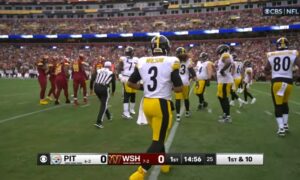Thanks to a holding penalty on Pittsburgh Steelers guard David DeCastro, the fourth quarter deep pass from quarterback Ben Roethlisberger to wide receiver Darrius Heyward-Bey wouldn’t have stood as a touchdown had it not been ruled an interception instead. With that disclaimer out of the way, I really wonder if this really should have even been ruled an interception.
As you can see in the animated gif below of the replay, it appears as though Heyward-Bey managed to pin the football to his chest and the right arm of Philadelphia Eagles cornerback Rodney McLeod prior to both players tumbling to ground in the end zone and both rolling over. At worst, it appears as though both players had simultaneous position of the football when they initially hit the ground and if that indeed was the case, the play probably should have been ruled a touchdown reception and then negated by the holding penalty.
I think we all remember what happened several years ago in the Monday night game between the Seattle Seahawks and the Green Bay Packers on the last-second Hail Mary pass from quarterback Russell Wilson to wide receiver Golden Tate that was ruled a touchdown and an interception by two different officials in the end zone. Even though that play went to official review, it was determined that no indisputable visual evidence existed to overturn the call on the field, and as a result, the final on-field ruling of touchdown stood.
Now, here are the applicable rules to the play as I understand them:
A player (or players) jumping in the air has not legally gained possession of the ball until he satisfies the elements of a catch listed here.
Rule 8, Section 1, Article 3 of the NFL Rule Book defines a catch:
A forward pass is complete (by the offense) or intercepted (by the defense) if a player, who is inbounds:
(a) secures control of the ball in his hands or arms prior to the ball touching the ground; and
(b) touches the ground inbounds with both feet or with any part of his body other than his hands; and
(c) maintains control of the ball long enough, after (a) and (b) have been fulfilled, to enable him to perform any act common to the game (i.e., maintaining control long enough to pitch it, pass it, advance with it, or avoid or ward off an opponent, etc.).
When a player (or players) is going to the ground in the attempt to catch a pass, Rule 8, Section 1, Article 3, Item 1 states:
Player Going to the Ground. If a player goes to the ground in the act of catching a pass (with or without contact by an opponent), he must maintain control of the ball throughout the process of contacting the ground, whether in the field of play or the end zone. If he loses control of the ball, and the ball touches the ground before he regains control, the pass is incomplete. If he regains control prior to the ball touching the ground, the pass is complete.
Rule 8, Section 1, Article 3, Item 5 states:
Simultaneous Catch. If a pass is caught simultaneously by two eligible opponents, and both players retain it, the ball belongs to the passers. It is not a simultaneous catch if a player gains control first and an opponent subsequently gains joint control. If the ball is muffed after simultaneous touching by two such players, all the players of the passing team become eligible to catch the loose ball.
Now, it certainly appears to me that at worst, Heyward-Bey shares simultaneous possession of the football with McLeod when the two players hit the ground and if that was indeed the case, this probably should have been ruled a touchdown and not an interception. Being as all turnovers are supposedly reviewed automatically, I’m sure that happened. However, when CBS came back from their commercial break there was no mention of the review, so I guess we can only assume that there wasn’t enough evidence in the replay angles to warrant the call on the field being overturned.
Once again, had this been ruled a touchdown, it would have been negated by a holding call. However, at least the Steelers would have retained possession of the football. Sure, in the grand scheme of things this play meant absolutely nothing but with that said, it would be interesting to hear from Dean Blandino as to why this was ruled an interception and not a touchdown for the Steelers and if indeed it was because there wasn’t enough evidence to overturn it during the official review.
Let me know if I missed anything related to this play and review in the comments below.









